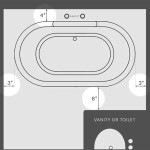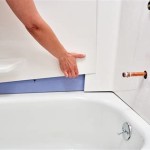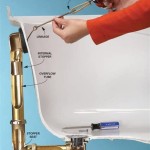Bathtub Baseboard: A Guide to Essential Aspects
Bathtub baseboard is an essential element in any bathroom, serving both functional and aesthetic purposes. It helps to create a watertight seal between the bathtub and the wall, preventing leaks and ensuring a secure and durable installation.
Choosing the right bathtub baseboard requires consideration of various aspects, including material, size, shape, and installation method. The following guide will provide an in-depth understanding of these essential factors to help you make informed decisions.
Material
The material of the bathtub baseboard determines its durability, resistance to moisture, and overall performance. Common materials used include:
- Ceramic tile: Durable, easy to clean, and comes in a wide range of colors and styles.
- Acrylic: Lightweight, flexible, and resistant to fading and scratching.
- Vinyl: Waterproof, flexible, and available in various textures and patterns.
- Wood: Natural, warm, and stylish, but requires regular maintenance to prevent moisture damage.
Size and Shape
The size of the bathtub baseboard should align with the dimensions of the bathtub and wall. It typically comes in standard heights, such as 4-inch, 6-inch, and 8-inch, and must be cut to fit the length of the bathtub's side.
The shape of the baseboard can vary, with options such as straight, curved, or contoured. Straight baseboards provide a classic and straightforward look, while curved or contoured baseboards add a touch of elegance and style.
Installation Method
The installation method depends on the material and type of baseboard chosen. Ceramic tile requires mortar and grout, while acrylic and vinyl baseboards typically use adhesive or caulk. Wood baseboards are often attached with nails or screws.
It's important to follow the manufacturer's instructions carefully for proper installation. Ensuring a watertight seal between the baseboard and the bathtub is crucial to prevent leaks and maintain the integrity of the bathroom.
Additional Considerations
Beyond the essential aspects discussed above, there are additional considerations that can further enhance the functionality and aesthetics of the bathtub baseboard:
- Matching the bathroom décor: Choose a baseboard that complements the style, color scheme, and fixtures of the bathroom.
- Including a flange: A flange on the baseboard helps to hide any gaps between the baseboard and the bathtub.
- Using a caulk bead: Applying a bead of caulk around the baseboard provides additional protection against moisture penetration.
Conclusion
Understanding the essential aspects of bathtub baseboard is crucial for a successful installation and long-lasting performance. By considering the material, size, shape, installation method, and additional factors outlined in this guide, you can ensure a watertight seal, enhance the aesthetics of your bathroom, and enjoy a safe and comfortable bathing experience.

How To Prevent Water Damage Your Baseboards

10 Bathroom Makeover Quick And Easy Bathtub Trim Hometalk

Diy Network Bathroom Baseboard Trim Merrypad

Vanilla Modern Baseboard Honed 5 X12 X1 16 Straight Cut Surface Group Marble Systems

Adding Custom Trim During The Bathroom Remodel

T The Floor Let S Face

Trojan Cascade 1700 X 700mm Single Ended Encapsulated Baseboard Bath B000692

Subway Tile Bathroom Baseboards Design Ideas

Sonoma Tilemakers Inspiration Gallery

Baseboards And Freestanding Soaker Tub Install
Related Posts








